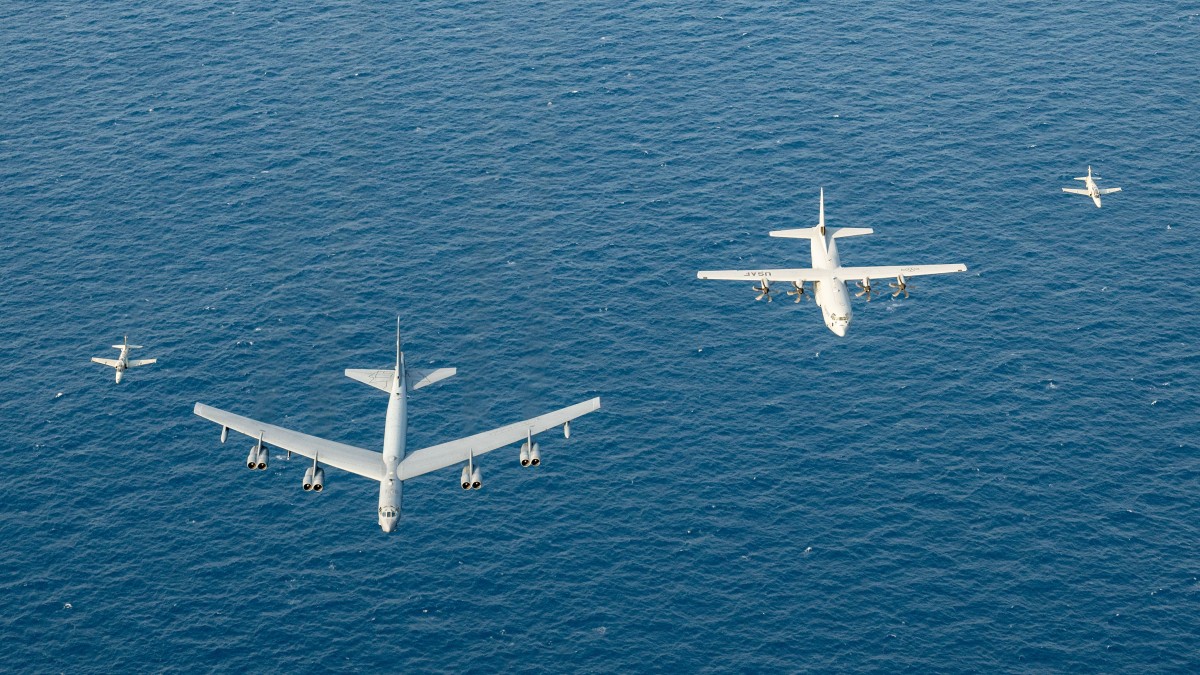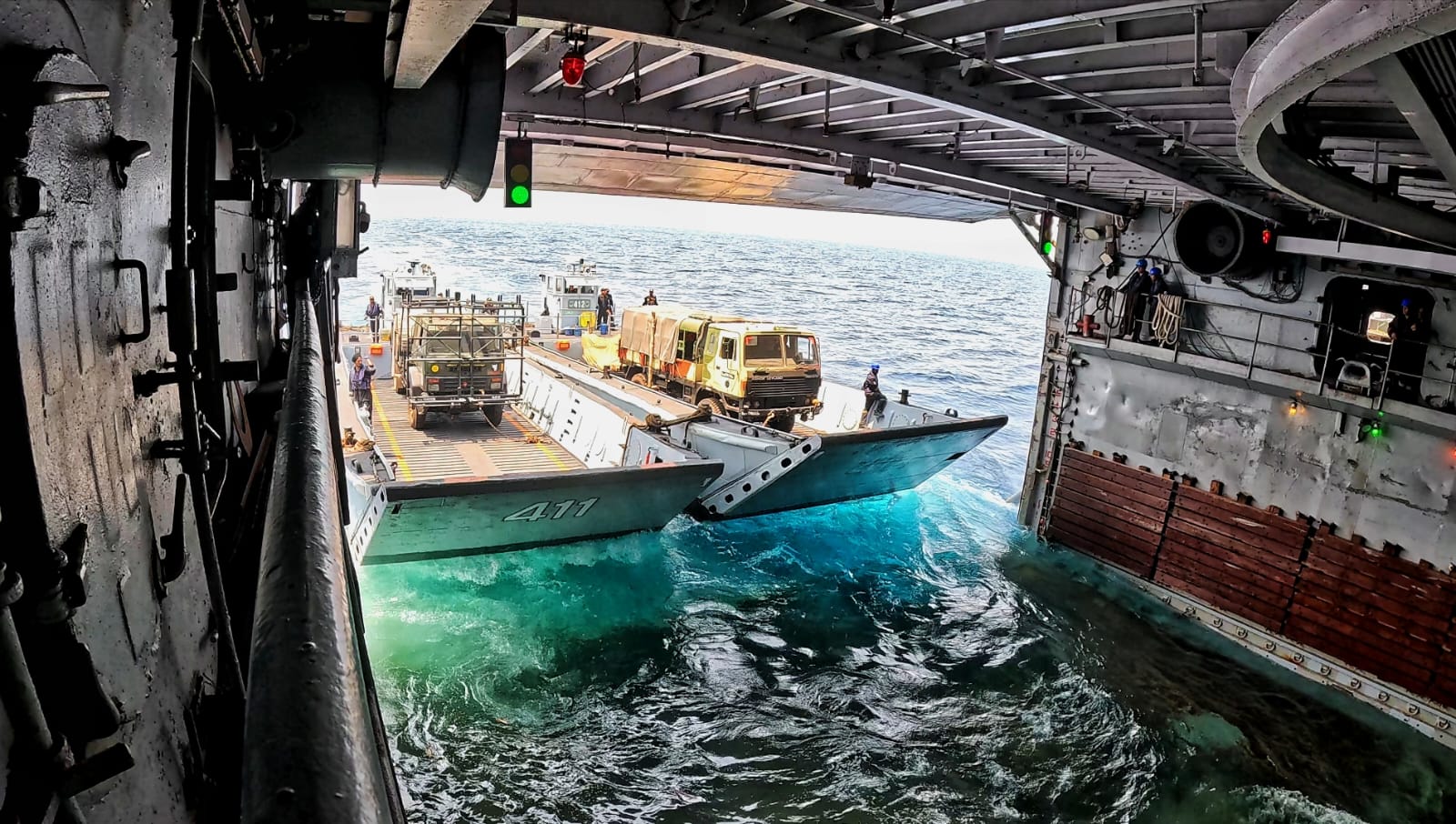The United States Pacific Air Forces has announced that a US Air Force B-52 Stratofortress and C-130J-30 Super Hercules flew in formation alongside Indian MK-132 Hawks from the Indian Naval Air Squadron 551 “Phantoms” over the Bay of Bengal.
The Pacific Air Forces took to X (formerly Twitter) on March 29 to announce this update and shared images of its participation with the Indian Navy in the Bay of Bengal.
In the shared images, two Indian Navy Hawk trainers can be seen alongside an American B-52 strategic bomber and a C-130J-30.
The post said, “A B-52 & C-130J-30 joined the Republic of India MK-132 Hawks over the Bay of Bengal with the US Navy. This display of cooperation marks Exercise Tiger TRIUMPH 2024, enhancing humanitarian assistance/disaster relief capabilities between the US & India.”
This collaborative display, part of Exercise Tiger TRIUMPH 2024, underscores the United States and India’s efforts to enhance their humanitarian assistance and disaster relief capabilities.
Additionally, the Indian Navy revealed that the US Marine Corps’ largest and heaviest helicopter, the CH-53E ‘Super Stallion,’ made its maiden landing at Naval Air Station INS Dega in Visakhapatnam.
🇺🇸✈️🇮🇳 A B-52 & C-130J-30 joined Republic of India MK-132 Hawks over the Bay of Bengal with the @USNavy. This display of cooperation marks Exercise Tiger TRIUMPH 2024, enhancing humanitarian assistance/disaster relief capabilities between the US & India. https://t.co/6Uiilv1Aer pic.twitter.com/czdT33S4Il
— PACAF (@PACAF) March 29, 2024
The Indian Navy said, “These heavy lift helicopters of the Marine Corps are operating from US Navy ships as part of the ongoing #ExTigerTriumph2024 in #Kakinada. In coordination with Indian Navy and Air Force helicopters, they have undertaken various transportation and #HADR missions.”
During a joint press conference at the Indo-US bilateral Human Assistance and Disaster Relief (HADR) exercise, Tiger Triumph, held at the Kakinada Naval base, US Navy Rear Admiral Joaquin Martinez emphasized the strength of both India and the USA’s defense forces in tackling challenges in the Indo-Pacific region.
Rear Admiral Martinez, who also serves as the Vice-Commander of the US Navy’s Seventh Fleet based in Japan, expressed confidence in the capabilities of both nations’ armed forces, stating that they were independently robust.
Addressing reporters, Rear Admiral Martinez highlighted the importance of seamless collaboration between the two nations in responding to crises in the Indo-Pacific region.
He stated, “In the Indo-Pacific region, crisis response is not a matter of the earth, but a question of the wind,” underlining the dynamic and unpredictable nature of challenges in the region.
However, he reassured that both India and the US have prepared to work together seamlessly to address any crisis that may arise.
Rear Admiral Martinez also lauded the growing relationship between the defense forces of India and the US, noting that this was evident during the joint amphibious exercise conducted off the Kakinada coast.
Exercise Tiger TRIUMPH 2024
The joint military forces of India and the United States kicked off Exercise Tiger TRIUMPH 2024 with the arrival of the USS Somerset (LPD 25), an amphibious transport dock ship, on March 18, followed by an opening ceremony on March 19.

This was the third occasion when US and Indian forces collaborated for Tiger TRIUMPH, an acronym standing for Tri-Services India U.S. Amphibious Exercise. Scheduled from March 18 to March 31, this combined exercise is being conducted near Visakhapatnam and Kakinada, India.
A battalion group comprising over 700 personnel from the Indian Army is actively engaged in Exercise Tiger Triumph 2024. The 14-day exercise unfolded in two distinct phases: the Harbour Phase held in Visakhapatnam and the Sea Phase in Kakinada.
The primary objective of the exercise is to enhance interoperability, strengthen bilateral ties, and refine capabilities in HADR as well as sub-conventional operations.
Throughout the exercise, the Indian Army demonstrated its adeptness in amphibious operations across various scenarios, showcasing its prowess through an integrated battalion group comprising infantry, mechanized infantry, Para SF, artillery, engineers, and other support arms.
The sea phase, which began on March 24 in Kakinada, featured a strategic maneuver to a simulated island nation, laying the groundwork for a series of complex operations. Among these was a ship-to-shore movement highlighting the precision and synchronization essential for amphibious endeavors.

The main aim of this joint exercise was to establish and oversee an Internally Displaced Persons (IDP) camp, underscoring the commitment of both forces to humanitarian assistance.
Exercise Tiger Triumph also facilitates Subject Matter Expert exchanges, cross-board visits, and friendly sports matches to foster camaraderie among troops. The smooth execution of multifaceted, coordinated operations reflects the meticulous joint planning and execution.
- Contact the author at ashishmichel(at)gmail.com
- Follow EurAsian Times on Google News




